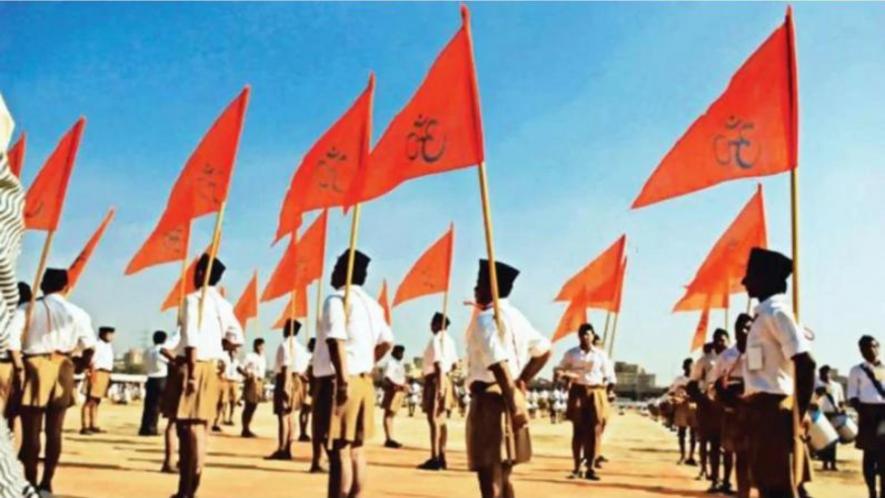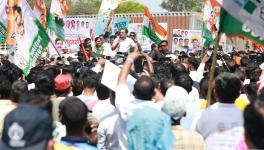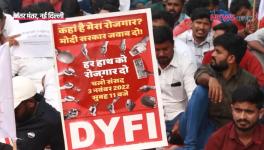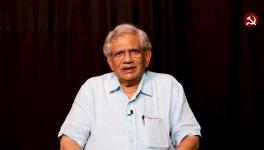Hindu Rashtra & the Art of Camouflage

File Photo
The Rashtriya Swayamsevak Sangh (RSS) was founded with the objective of establishing a Hindu Rashtra, or a Hindu State. The question immediately arises: what is a Hindu State?
There are several countries in the world that give primacy to one religion above all others, or are theocratic, but that makes not an iota of difference to the class nature of their states.
A Hindu State, likewise, if it ever materialises, may swear by one religion above all others, but its class nature would not be defined thereby. It would necessarily be, for reasons we shall discuss, a dictatorship using terror, underwritten by monopoly capital, especially by the newer and more aggressive elements of monopoly capital.
Georgi Dimitrov, the president of the Communist International, had defined the fascist State at its Seventh Congress as a “terrorist dictatorship of the most reactionary and revanchist sections of finance capital”; our argument, therefore, amounts to saying that a Hindu Rashtra would essentially be a fascist State.
In such a State, all official events might begin with invocations to Hindu deities; all roads, railway stations, or cities might have their names changed from those of medieval emperors to those of Hindutva icons; all educational functions might start with Saraswati Vandana; and many more temples might be built, even with State funding. But none of it would cause any improvement in the life of the average Hindu, any more than the Erdogan government’s conversion of the renowned Hagia Sophia in Istanbul to a functioning mosque, in its desire to appeal to Islamic sentiments, has caused any improvement to the life of the average citizen in Turkey.
In fact, one can go further. Let us first consider the experience we have had under the present rule of the Hindutva elements.
Unemployment in the country now is worse than it has been for decades: according to the Centre for Monitoring the Indian Economy (which, in line with general international practice, does not count unpaid family labour as employment), the unemployment rate has increased from an average of between 5% and 6% between 2008 and 2019, to nearly 8% now; and that is not taking into account those who do not report for work because of the “discouraged worker effect”.
But not only has the government led by the Hindutva elements failed to arrest this worsening trend, its chief economic adviser has even made an open declaration that the government can do little about unemployment. He has neither retracted his statement, nor has there been an attempt by any official source to dissociate the government from his statement, which clearly suggests that it is the government’s position as well.
Thus, on the most burning issue affecting the working people, an issue that underlies the current worsening plight of the working masses, the government has simply announced its intention not to act.
This means that the growing misery of the people will continue under the present government, whose response will be only to tom-tom the supposedly impressive growth rate of the spuriously estimated gross domestic product, which can then be used to justify the largesse being doled out by the State in the name of “development” to the monopoly bourgeoisie, and to pour scorn on all dispassionate attempts to present a true picture of the growing misery.
If this is what an elected government dominated by Hindutva elements is doing, then any future Hindu Rashtra will only further consolidate the institutionalised nonchalance of the State towards people’s material lives.
It is for this reason that the future Hindu Rashtra will have to be a dictatorship using terror. Any rule by the propertied classes over the working people is sustained by a State that represents a class dictatorship, even when the form of government is democratic.
To say this does not mean that the democratic form is irrelevant or represents only an epiphenomenon; it is simply to underscore that the democratic form itself remains attenuated by the class dictatorship within which it is ensconced. But when this class dictatorship results in an actual worsening of the condition of the people, if the State does not do anything about it, then this class dictatorship will necessarily have to further strangulate the democratic form of the government. It will necessarily trample over the people’s rights and the institutions of democratic governance.
The Hindu Rashtra, if it comes into being, as a class dictatorship under the aegis of monopoly capital, and hence operating within a neo-liberal framework into which the monopoly bourgeoisie is integrated, will necessarily worsen the plight of the working people, especially in a period of crisis of neo-liberalism. It will, therefore, necessarily develop into a dictatorship using terror.
In fact, this is precisely why the bulk of the monopoly bourgeoisie might acquiesce in the Hindu Rashtra project. The complement to terror would be a stoking of communal strife, the “othering” of a minority religious group, and the fomenting of hatred against that group, all of which would be crystallised through the formation of a Hindu Rashtra.
The dictatorship using terror of monopoly capital, therefore, would have as its complement the stoking of Hindu supremacism crystallised in a Hindu Rashtra. This is why we mentioned at the outset that the Hindu Rashtra would necessarily constitute a dictatorship using terror under the aegis of monopoly capital.
Apart from these two planks, namely, the use of terror and the fomenting of Hindu supremacism, the third mobilisation plank of a Hindu Rashtra would be the unleashing of a social counter-revolution.
The 20th century had seen two parallel movements unfolding in India: one was the anti-colonial struggle and the other was the struggle for emancipation of those who had been socially oppressed for millennia within the caste-based feudal society. Many leaders of one movement may not have been personally sympathetic to the other, but there was a symbiotic relationship between the two at the popular level; and the Left expressed this symbiosis.
As a result of this twin movement, there was an immense social transformation that occurred in the country. It was, of course, not as thorough-going as it should have been; it remained circumscribed by the bourgeois limits that could not be transcended. Nonetheless, it represented a significant advance, which can be illustrated by just one example.
At the beginning of the 20th century, within the region that now constitutes Kerala, there was not only “untouchability”, but even “unseeability”, which meant that a person belonging to a “high” caste was supposed to get polluted just by seeing a person of the depressed caste.
When we compare that situation with the Kerala of today, whose human development indicators are not only better than those of most Third World countries, but often even compare favourably with those in the advanced capitalist world, we get an idea of the immensity of social change that has occurred. True, Kerala is in an obvious sense an outlier; but such a change, though less than in Kerala, has also occurred in varying degrees all over India.
The ascendancy of Hindutva has been aided by its implicit promise, and actual effort, to reverse that transformation. Its reversal of this transformation in the political and social spheres, by attenuating democracy which had empowered the people politically, and by rolling back secularism, are well-known; but this reversal is much more pervasive. For instance, the privatisation that occurs under Hindutva-led neo-liberalism, including in the sphere of education, leads to an exclusion of the socially-deprived from jobs and opportunities, which is a reversal of the earlier trend.
The upper middle class that has been a beneficiary of the neo-liberal regime and that has split itself off from the mass of the working people with little sympathy for the latter, is a supporter of this counter-revolution.
The point is that if the ascendancy of Hindutva itself has been associated with a rolling back of the social transformation that had occurred in India over the past several years, then clearly a Hindu Rashtra will entail a veritable counter-revolution.
Words can be highly deceptive; and Hindu Rashtra is a perfect example of this. The propaganda machine of the Hindutva forces makes out the Hindu Rashtra as if its arrival would be a moment of liberation for Hindus. On the contrary, however, the Hindu Rashtra would constitute a camouflage for a dictatorship exercised in the interests of monopoly capital while shoring up a neo-liberal regime that is caught in a crisis.
Far from being in the interests of the majority, it signifies the unleashing of a counter-revolution that would reverse much of the social and political gains the people have made over the last century. It, therefore, becomes the historic duty of the working class, in alliance with the peasantry, to prevent any move towards a Hindu Rashtra.
Get the latest reports & analysis with people's perspective on Protests, movements & deep analytical videos, discussions of the current affairs in your Telegram app. Subscribe to NewsClick's Telegram channel & get Real-Time updates on stories, as they get published on our website.
























